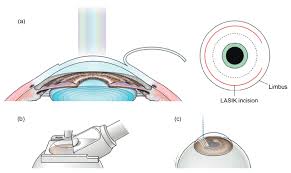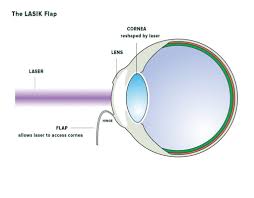Table of Contents
ToggleNo, you do not have to be admitted to a hospital or clinic for LASIK surgery.
LASIK (Laser-Assisted in Situ Keratomileusis) is an outpatient procedure, meaning you can have the surgery and go home on the same day. It’s one of the simplest and most convenient ways to correct vision problems, which makes it highly appealing to those seeking freedom from glasses and contact lenses.
But there’s more to LASIK than just its convenience.
It is essential to have a clear understanding of what to expect before, during, and after the procedure if you are considering undergoing the surgery. From eligibility criteria and the surgery itself to aftercare and potential risks, this blog will guide you step-by-step through the LASIK experience.
What Is LASIK and How Does It Work?
LASIK is a type of refractive eye surgery specifically developed to correct prevalent vision issues, including myopia (nearsightedness), hyperopia (farsightedness), and astigmatism. During the procedure, an ophthalmologist uses a precision laser to reshape your cornea, allowing light to properly focus on your retina. This leads to improved clarity of vision without the reliance on corrective lenses.
Advances in LASIK technology have made the procedure highly accurate, minimally invasive, and incredibly fast—it typically takes less than 30 minutes to perform. But perhaps its biggest selling point is the freedom it offers. Imagine waking up and seeing clearly without having to fumble for your glasses or pop in contact lenses.
Why You Don’t Need to Be Admitted
Unlike traditional surgeries that require hospital admission, LASIK is designed for quick and simple execution. Here’s why you don’t need to pack a bag for an overnight stay:
- Outpatient Procedure: LASIK is performed in a specialised clinic equipped with advanced laser technology. No hospital beds or extended observations are necessary.
- Local Anaesthesia: The surgery is done under local anaesthesia, usually in the form of numbing eye drops. There’s no need for general anaesthesia, vastly reducing recovery time.
- Quick Recovery: While your eyes may take a few weeks to fully heal, most people can return to their regular routines within 24 to 48 hours after the surgery.
- Minimal Risks: Thanks to its precision, the chances of complications are low, reducing the need for post-surgery monitoring.
It’s this outpatient nature of LASIK that makes it so accessible for people who want to improve their vision without disrupting their schedules too much.
LASIK Eligibility – Are You a Candidate?
Before you can even consider LASIK, you’ll need to determine whether you’re eligible for the procedure. A thorough eye examination with a qualified ophthalmologist will assess multiple factors.
Key Eligibility Criteria:
1. Age Requirements
You must be at least 18 years old, although many surgeons recommend waiting until the mid-20s when your prescription is more likely to stabilise.
2. Stable Prescription
Your glasses or contact lens prescription should remain stable for at least a year before the surgery. Significant fluctuations could affect the results.
3. Eye Health
Your eyes should be free from conditions like keratoconus (a thinning of the cornea), severe dry eyes, or infections.
4. Corneal Thickness
LASIK reshapes your cornea, so it must be thick enough to allow for safe laser application.
5. General Health
Certain autoimmune diseases or conditions such as diabetes may rule you out as a candidate.
6. Pregnancy
Hormonal changes during pregnancy can temporarily alter your vision, so it’s best to wait until after childbirth and breastfeeding.
If you meet these criteria, you could be a good candidate for LASIK. Remember, only a comprehensive evaluation by a specialist can confirm your eligibility.
How to Prepare for LASIK
Proper preparation for LASIK is essential to ensure a seamless experience and achieve the best possible outcomes. The following steps are recommended in the days leading up to your procedure:
1. Cease Wearing Contact Lenses
Contact lenses can alter the shape of your cornea, so you’ll need to stop wearing them before your pre-surgery assessment (usually 2 weeks for soft lenses and longer for rigid ones).
2. Discuss Medications and Medical History
Inform your surgeon about any medications or medical conditions you have, as they could influence the surgery or recovery.
3. Avoid Eye Makeup
On the day of your surgery, skip eye makeup, lotions, or creams to minimise the risk of infection.
4. Arrange Transportation
Since your vision will be blurry immediately after the procedure, you’ll need someone to drive you home.
5. Ask Questions
Don’t hesitate to ask your surgeon any questions about the procedure. Understanding what to expect can be reassuring.
What Happens During the LASIK Procedure?
Now that you know you don’t need to be admitted, you might wonder what the procedure itself involves.
1. Numbing the Eyes
Your surgeon will apply numbing drops to prevent any discomfort during the surgery. You’ll remain awake but won’t feel pain.
2. Creating the Flap
A small flap is created on your cornea using either a microkeratome blade or a femtosecond laser. The flap is elevated to permit access to the underlying corneal tissue.
3. Reshaping the Cornea
The surgeon utilizes a computer-guided excimer laser to reshape the cornea, addressing specific vision impairments. The procedure typically requires approximately 10 minutes per eye.
4. Closing the Flap
Once the cornea is reshaped, the flap is repositioned, where it naturally adheres without the need for stitches.
5. Post-Surgery Checks
After the procedure, your surgeon will briefly examine your eyes to ensure everything went smoothly. You’ll then be free to go home.
Recovery & Aftercare
The recovery process following LASIK surgery is typically swift, with most individuals experiencing improved vision within 24 hours. However, diligent care is crucial to safeguard your eyes and ensure optimal outcomes.
Recovery Tips:
- Follow Post-Op Instructions
Administer prescribed eye drops as directed to prevent infection and facilitate healing.
- Avoid Rubbing Your Eyes
This could dislodge the corneal flap and delay healing.
- Wear Protective Sunglasses
Your eyes will be more sensitive to light, so wear sunglasses outdoors.
- Limit Screen Time
Reduce eye strain by limiting time spent on digital devices.
- Attend Follow-Up Appointments
Routine examinations will ensure that your eyes are healing properly.
Potential Side Effects:
Though uncommon, some patients may experience:
- Dry eyes
- Mild discomfort or itching
- Halos or glare around lights at night
These side effects are usually temporary.
Benefits of LASIK
LASIK has become one of the most popular vision correction surgeries for good reason. Its benefits include:
- Improved vision without the need for glasses or contact lenses
- A fast and painless procedure
- Quick recovery time
- Long-lasting results
- Enhanced quality of life
Is LASIK Right for You?
While LASIK offers a life-changing solution for many, it’s not for everyone. If you’re unsure about whether it’s the right option, schedule a consultation with an experienced ophthalmologist. This consultation will address your suitability for the procedure and help you make an informed decision.
In Closing
LASIK is a revolutionary procedure that doesn’t require hospital admission or lengthy downtime. Its outpatient nature, combined with its fast recovery and impressive results, makes it an excellent option for vision correction.
If you’re ready to say goodbye to glasses or contact lenses, speak to a LASIK specialist today to explore your options. Improved vision is just a few minutes away!













